► Hardcore hot hatches tested
► Hottest Megane and Mini
► Last of a dying breed?
Yes, yes, okay. Let’s get the price out of the way first. There is a £16,000 difference between these two, enough for a VW Up GTI. But more than any other hot hatch pairing in the world today, these are kindred spirits.
Both the new £35k Mini John Cooper Works GP and the £51k Renault Megane RS Trophy-R have binned their back seats to save weight, waved goodbye to ride comfort with ruthlessly focused suspension set-ups, and somehow squeezed near-enough 300 horsepower through their front wheels only. They’ve also squeezed their production run down to a limited series, in the Megane’s case to 500 cars worldwide (32 for the UK) and a less exclusive 3000 for the Mini (575 for the UK). And both are once-in-a-lifecycle cars – this is the third Mini GP in 14 years (officially, it’s called the GP3), and the third fully committed Megane; the first was 2008’s plastic-windowed R26R, the second 2014’s 275 Trophy-R. The Renault holds the Nürburgring Nordschleife lap record for front-wheel-drive production cars at 7min 40.1sec, and the Mini GP3 too has lapped it in under eight minutes. That’s quicker than a BMW M2.
So if you want the most hardcore hot hatch on sale today, one that’s closer to a sports car than a shopping car, these are the two hottest in the world right now. Which offers the hardest hit?
Mini name, massive thrills
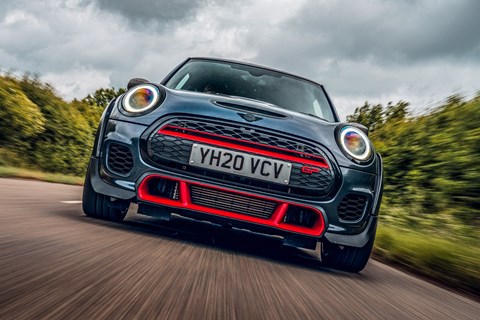
The Mini GP comes out swinging, from the moment its turbo 2.0-litre four-cylinder fires up with a guttural smoker’s cough, adding a couple of hacking fuel-pop exclamation marks from its stubby twin exhausts. There’s something of the cartoon character about the GP3, from its hooped boot spoiler to its giant aero side spats, flaring from the body like the wings from Hermes’ sandals. Fashioned from carbonfibre recycled from BMW i3 and i8 production, with a raw matt finish that makes them look like they constantly need a good clean, they enable the GP to sit on wider tracks without altering the standard bodyshell. Deliberately, no attempt has been made to blend them visually; the wheelarch pressings of the base car’s shell beneath jar unashamedly with the aero shrouds.
Read our Mini GP review
On the move, the Mini feels as purposeful as it looks from the get-go, fizzing down the road with the energy of a rattled Coke can. The suspension is unyieldingly firm, the driver’s seat slapping you on the back like an overly rowdy mate who’s had a few too many pints. The regular Mini JCW, from which this car is a mutant evolution, is available with adaptive dampers but the GP rides on passive, track-focused shocks. You need a firm grip on the steering, which pulls at cambers, torque-steers under power and occasionally multiplies the effect of both at the same time. No wonder CAR’s Georg Kacher found the GP3 eye-openingly twitchy on the autobahn where he clocked an indicated 175mph, 11mph beyond its quoted top speed [CAR, June 2020] – it feels a handful at a third of that pace. But in terms of outright grip, at sub-Georg speeds at least, it’s ultimately tenacious. Even on these rollicking roads of Lincolnshire and Cambridgeshire – natural hot-hatch habitat – you’d have to be trying really hard for the Mini to get properly bent out of shape. Most corners disappear on fast-forward, the steering wheel there to hang on to as much as steer with, while the grippy tyres and mechanical locking diff take care of business.
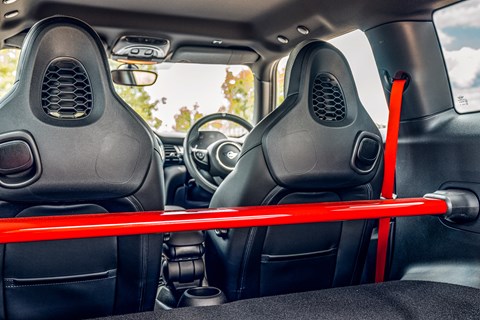
Its 302bhp engine, closely related to that of the BMW M135i/M235i xDrive, albeit with a new turbo and intake system, is as flexible as it is brawny, deploying its 299lb ft of torque from only 1750rpm. First flattening of the throttle, on a slip road in the wet in this case, is enough to make you giggle and blurt expletives (while also tightening your grip to keep the thing in a straight line). It really is ballistic. There’s a hot-rod feel to the GP, the appealing sense of a car with an engine that’s too much for it.
The strictest of French diets
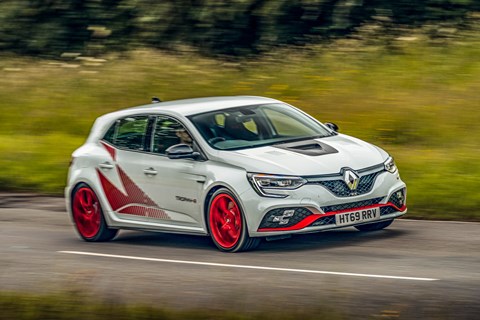
If the Mini feels purposeful, like swinging a baseball bat, swapping into the Megane feels like picking up a carbonfibre tennis racquet. The thing that gets you first is the sense of lightness. The Megane is the larger car and is actually 60kg or so heavier than the Mini, but it feels the other way around. Depending on which options are ticked, the Trophy-R weighs a full 130kg less than the Megane Trophy it’s based on, helped by a NACA-ducted carbon bonnet, titanium exhaust and sundry other dieting measures. It doesn’t have plastic rear windows like the original R26R but they are made from thinner glass, saving a kilo. Renault Sport has also deleted the four-wheel steering system fitted to regular hot Meganes to cut 32kg, the weight saving around a ‘Ring lap outweighing the system’s dynamic advantages.
Read our Renault Megane RS review
At first, it almost feels like the rear-steer kit’s still there. The Trophy-R turns in so immediately, with such a lack of inertia, it’s as if you think it into a corner rather than physically turn it. We’re already aware of the two-seat Megane’s abilities from its supercar-bothering performance in last year’s Sports Car Giant Test in Wales. The car in that test was worth £72k, fitted with £12k carbon wheels and £9k worth of carbon brakes. This one is in ‘standard’ £51k form, with scarlet alloy wheels in place of the carbon set. I’d thought the immediacy of the steering in Wales was a factor of the composite wheels’ and brakes’ featherweight unsprung mass, but much of that same sense of immediacy is here in this alloy-rimmed Megane.
Even just pulling out of a parking space it feels taut and alert, tyres padded out into the tarmac at each corner like a sumo wrestler stomping his ground. Like the Mini, the damping’s seriously firm but the body control is so uncanny that the Megane feels the more comfortable car. Maybe it’s the longer wheelbase, maybe the serious suspension components (adjustable Öhlins dual-flow valve dampers and lightweight springs, both contributing towards that toppy price tag) but the upshot is that the Megane jiggles but doesn’t jostle you.
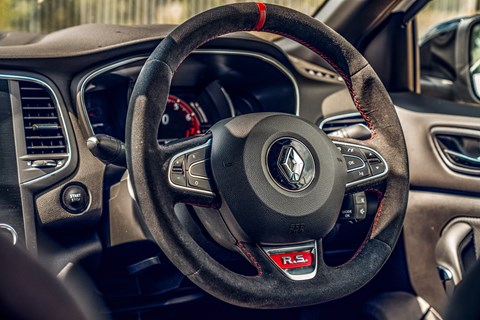
That’s not to say there’s much give in the suspension – on this patchwork quilt of roads, I’m lifted clean out of the seat a couple of times (and find there’s plenty of headroom, if any tall prospective buyers are reading). But equally, it never grounds its nose.
A big, wide roundabout: turn-in at a leisurely pace in third gear and experimentally lift the throttle. Straight away the Megane pivots its nose inwards and its tail outwards, with a barrage of fire from the titanium exhaust on the overrun. This car is not messing about. Like the Mini, however, it’s not likely to get out of shape on the road unless seriously provoked. The Renault’s grip levels are closer to those of a track car than something with number plates, and most corners are dispatched with an ‘Is that the best you can do?’ shrug.
The wickedest bit of witchcraft at play in the Megane is its lack of torque steer. Despite the 296bhp and 295lb ft coursing through its dual-axis front suspension struts, it goes exactly where you point it, with minimal kickback or protest through the wheel. The Mini feels like a pack of ferrets are writhing round the steering column by contrast. The Renault’s steering is much lighter than the Mini’s fast-responding but relatively heavily weighted power steering, and slightly more measured in ratio, making it feel less darty and keen but ultimately more accurate. Neither offers quite as much feel and feedback as you might hope, but with so much grip on the ground, perhaps that’s not a surprise.
The Megane wears bespoke Bridgestone tyres like port wine gums with grooves. The Mini’s high-end Hankooks have a more road-focused tread pattern that looks less like they’ve been pinched from a pitlane but both cars grip like glitter to Pritt Stick, and cope reassuringly well in the wet, too (in moderate rain on a warm day, at least).
Stripped back and hardcore
Inside, both sport a bright red bar spanning the rear of the cabin. In the Megane it bridges a giant plastic moulding, designed to carry spare tyres for a trackday – it’s that kind of car – and the GP a big empty well, which actually makes it rather more practical for shopping than a regular Mini (provided you don’t mind retrieving errant spuds and cans of chopped tomatoes at journey’s end).
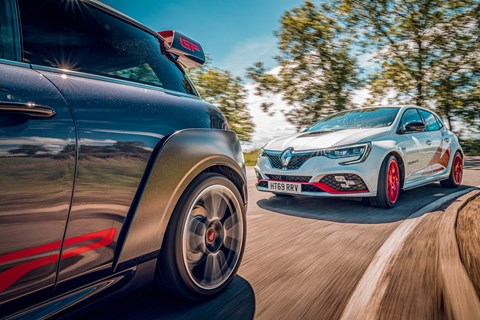
There’s a fair bit of road noise in the Megane, not to mention faint rattles from the empty cabin behind you, and cats’ eyes thunk against the tyres like rubber bullets slamming into the underside of the body – but you could hold a conversation or listen to the radio on the motorway, no bother. The Trophy-R keeps the Megane’s infotainment system and reversing camera, albeit on a smaller screen than the regular model (in the name of shaving grams), while the GP as standard comes without air-con, seat heaters or any kind of media system. The optional £2000 Touring Pack, fitted here, adds them back in; most sane people will surely spec the pack. Despite the gulf in price, the Mini feels the more expensive car inside. Like the previous Trophy-R, the Megane’s front cabin is entirely ordinary-looking, other than its furry suede steering wheel and Sabelt bucket seats, which look fantastic but don’t offer me quite as much side support as I’d like. The Mini’s relatively plush sports seats, from the regular JCW, are height- and backrest-adjustable where the Renault’s are fixed, but in both cars you can’t help feeling you sit just a bit too high.
Subjectively, it’s the Mini that feels the more potent of the two in a straight line. A shade lighter and more powerful than the Megane (302bhp and 299lb ft versus 296bhp and 295lb ft), where the Renault feels rapid, the GP feels startlingly so. The Megane’s 1.8-litre aluminium engine is the most powerful yet installed in a production Renault but the Mini’s burlier 2.0-litre is the more charismatic powerplant, in both its brusque sound and its broad-muscled torque.
Where it loses personality points is in the transmission it’s paired with. Both previous Mini GPs were manuals, but the GP3 is an eight-speed auto. Official word from Mini’s chief dynamics man Jürgen Metz is that a manual just wouldn’t have been viable to get the car to market. Today’s customers prefer autos, and the extra validation process wouldn’t have stacked up for a limited production run. It’s a shame; the stab-clutch-pedal, grab-another-gear, tighten-grip-with-other-hand-on-wheel process was a key part of the previous GP’s frantic character.
That said, the GP3’s transmission is excellent; docile in town, and manual mode really does mean manual – the engine runs into a soft limiter rather than upshift automatically, giving you greater control – but it lacks drama. The Trophy-R is manual-only (again, in the name of weight saving) and while it’s hardly a classic – the slightly notchy shift action is workmanlike – it does its job well. The ratios are well chosen, third gear being flexible enough to decimate a British B-road, and the warning beeps at the redline give it more of a sense of crescendo than you get in the Mini.
Shame the Renault’s engine doesn’t sound a bit more dramatic. The old Megane 275 Trophy-R’s combination of exhaust and induction roar made a sound at the redline like tearing paper. The new R sounds more hairdryer than humdinger, a surprise given the delicious-looking titanium exhausts barrelling through the deep diffuser.
Fortunately the Trophy-R looks great – with a low-slung stance and heavily cambered wheels filling its broad arches, it looks entirely fit for purpose. It’s available in any colour you like so long as it’s white, but thankfully the stickers are optional. The Renault’s smooth bodywork is the antithesis of the Mini, avoiding big spoilers to draw aerodynamic performance primarily from airflow beneath the car.
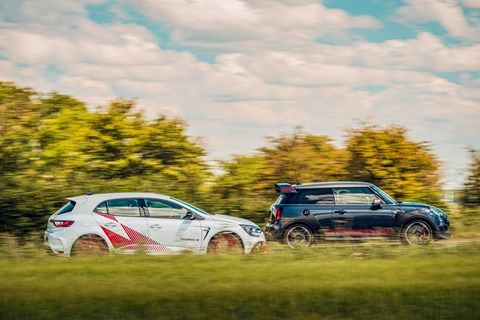
Both the decal-clad Megane and bewinged Mini get plenty of stares, from passers-by and rubber-necking drivers. It’s hard not to feel a little self-conscious. When I ran CAR’s long-term-test Audi R8 a while back, it was like a mothership beacon for Audi drivers. No dual-carriageway journey was complete without an A3 glued to the rear bumper.
The GP has the same effect on Minis. You travel everywhere with Mini hatches and convertibles in your wake, like a shoal of round-eyed fish. It’s easy to shake them off as soon as a corner or two appears. Point-to-point, I don’t think there are many cars on the planet, with any combination of driven wheels, that could live with either of these two.
But both are also studies in the law of diminishing returns. I’m pretty sure I’d have just as much of a giggle on these roads in a £22k Ford Fiesta ST, and perhaps even more fun in both these cars’ previous generations. First time I drove 2012’s Mini GP2, I popped out for a quick drive and accidentally ended up in Bedford, about 40 miles further than I’d intended to travel. I just didn’t want the journey to end. The new GP is addictive too but not quite as raw or engaging as the old car, even if it is faster.
Much the same is true of the Megane. The new Trophy-R leaves me feeling a bit inadequate – every corner, you think you could have braked later, carried more speed, got on the power sooner. On the public road, you’re barely scratching the surface of its potential. The previous Trophy-R felt like you were extending it a bit more, making more of a difference.
It’s perverse, of course, to criticise a car for being better. The Megane is a stunning achievement. Its price is commensurate with its depth of engineering, and it feels more like a car designed from the ground up than a bitsa like the Mini. But the GP has its own charm. It’s more engaging than the Trophy-R at lower speeds, partly because it’s less polished, a bit rawer. For £16k less, you’re arguably having more fun. On the road the Megane is almost too able for its own good. But as an exemplar of what is possible – the ultimate expression of what a hot hatch can be – it wins this test.
One more question to answer: for how long will cars like this continue to be made? Mini’s Metz says ‘it’s getting tougher’ to make cars like the GP, but believes there is the expertise within the BMW group to make a future GP4. The wider world may have other ideas, though. Fleet emissions are becoming more pressing for company boards than Nordschleife times.
What of Renault Sport? Its Dieppe plant, which makes the Alpine A110, is under threat of closure at the time of writing as Renault seeks to save much-needed cash. It’s thought one reason the Trophy-R was released early in this Megane iteration’s lifecycle was to get it into the wild before emissions regs tighten further. The next RS model is more likely to be a hot version of the electric Zoe than an extreme petrol hatch. Peugeot’s boss has also intimated its next hot hatch will be an EV, and Ford has canned the next-gen Focus RS because it simply couldn’t make the numbers stack up for the development of a CO2-slashing new hybrid powertrain.
But there’ll be at least one more happy hardcore hatch – Honda’s Limited Edition version of its Civic Type R, CAR’s reigning hot hatch champ, which hangs onto its rear seats but deletes air-con, touchscreen and soundproofing. Even the Trophy-R may not be the world’s hardest hatch for long…
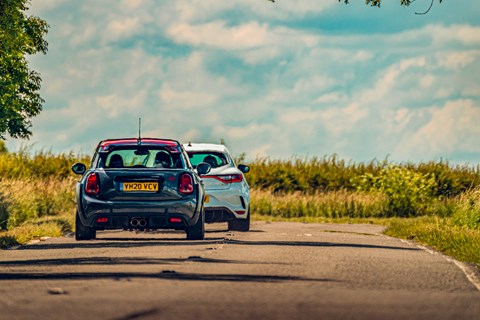
Renault Megane RS Trophy R
★★★★★
Mini GP
★★★★★
Check out more CAR comparison tests here